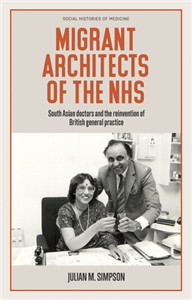Migrant architects of the NHS
South Asian doctors and the reinvention of British general practice (1940s-1980s)
by Julian Simpson, Keir Waddington
Description
More Information
Rights Information
Albania, Algeria, Angola, Argentina, Armenia, Australia, Austria, Bahrain, Belgium, Belize, Benin, Bolivia, Bosnia and Herzegovina, Botswana, Brazil, Bulgaria, Burkina Faso, Burundi, Cameroon, Canada, Cape Verde, Central African Republic, Chad, Chile, China, Colombia, Comoros, Congo [DRC], Congo, Republic of the, Costa Rica, Ivory Coast, Croatia, Czech Republic, Denmark, Djibouti, Ecuador, Egypt, El Salvador, Equatorial Guinea, Eritrea, Estonia, Ethiopia, Faroe Islands, Finland, France, French Guiana, Gabon, Gambia, Georgia, Germany, Ghana, Greece, Guatemala, Guinea, Guinea-Bissau, Guyana, Honduras, Hong Kong, Province of China, Hungary, Iceland, India, Indonesia, Iran, Iraq, Ireland, Israel, Italy, Japan, Jordan, Kazakhstan, Kenya, Kuwait, Latvia, Lebanon, Lesotho, Liberia, Libya, Lithuania, Luxembourg, Macau, China, Macedonia [FYROM], Madagascar, Malawi, Malaysia, Mali, Malta, Mauritania, Mauritius, Mayotte, Mexico, Mongolia, Montenegro, Morocco, Mozambique, Namibia, Netherlands, New Zealand, Nicaragua, Niger, Nigeria, Norway, Oman, Pakistan, Panama, Paraguay, Peru, Philippines, Poland, Portugal, Puerto Rico, Qatar, Reunion, Romania, Russia, Rwanda, Saint Helena, Sao Tome and Principe, Saudi Arabia, Senegal, Serbia, Seychelles, Sierra Leone, Singapore, Slovakia, Slovenia, Somalia, South Africa, South Korea, Spain, Sri Lanka, Sudan, Suriname, Swaziland, Sweden, Switzerland, Syria, Taiwan, Province of China, Tanzania, Thailand, Timor-Leste, Togo, Tokelau, Tunisia, Turkey, Uganda, Ukraine, United Arab Emirates, United Kingdom, United States, Uruguay, Venezuela, Vietnam, Western Sahara, Yemen, Zambia, Zimbabwe, South Sudan
Endorsements
The NHS is traditionally viewed as a typically British institution; a symbol of national identity. It has however always been dependent on a migrant workforce whose role has until recently received little attention from historians. Migrant architects draws on forty-five oral history interviews (forty with South Asian GPs who worked through this period) and extensive archival research to offer a radical reappraisal of how the National Health Service was made. This book is the first history of the first generation of South Asian doctors who became GPs in the National Health Service. Their story is key to understanding the post-war history of British general practice and therefore the development of a British healthcare system where GPs play essential roles in controlling access to hospitals and providing care in community settings. Imperial legacies, professional discrimination and an exodus of UK-trained doctors combined to direct migrant doctors towards work as GPs in some of the most deprived parts of Britain. In some areas they made up more than half of the GP workforce. This book documents the structural dependency of British general practice on South Asian doctors. It also focuses on the agency of migrant practitioners and their transformative roles in British society and medicine. Migrant architects is aimed at students and academics with interests in the history of immigration, immigration studies, the history of medicine, South Asian studies and oral history. It will also be of interest to anyone who wants to know more about how empire and migration have contributed to making Britain what it is today.
Reviews
The NHS is traditionally viewed as a typically British institution; a symbol of national identity. It has however always been dependent on a migrant workforce whose role has until recently received little attention from historians. Migrant architects draws on forty-five oral history interviews (forty with South Asian GPs who worked through this period) and extensive archival research to offer a radical reappraisal of how the National Health Service was made. This book is the first history of the first generation of South Asian doctors who became GPs in the National Health Service. Their story is key to understanding the post-war history of British general practice and therefore the development of a British healthcare system where GPs play essential roles in controlling access to hospitals and providing care in community settings. Imperial legacies, professional discrimination and an exodus of UK-trained doctors combined to direct migrant doctors towards work as GPs in some of the most deprived parts of Britain. In some areas they made up more than half of the GP workforce. This book documents the structural dependency of British general practice on South Asian doctors. It also focuses on the agency of migrant practitioners and their transformative roles in British society and medicine. Migrant architects is aimed at students and academics with interests in the history of immigration, immigration studies, the history of medicine, South Asian studies and oral history. It will also be of interest to anyone who wants to know more about how empire and migration have contributed to making Britain what it is today.
Author Biography
Julian M. Simpson is an Independent Scholar and a member of the committee of the Oral History Society
Manchester University Press
Manchester University Press is a leading UK publisher known for excellent research in the humanities and social sciences.
View all titlesBibliographic Information
- Publisher Manchester University Press
- Publication Date November 2019
- ISBN/Identifier 9781526145017 / 1526145014
- Publication Country or regionUnited Kingdom
- Pages336
- ReadershipGeneral/trade; College/higher education; Professional and scholarly
- Publish StatusPublished
- Dimensions216 X 138 mm
- SeriesSocial Histories of Medicine
- Reference Code12668
Manchester University Press has chosen to review this offer before it proceeds.
You will receive an email update that will bring you back to complete the process.
You can also check the status in the My Offers area

Please wait while the payment is being prepared.
Do not close this window.



